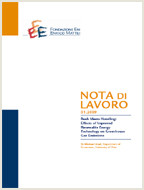On the Mechanism of International Technology Diffusion for Energy Productivity Growth

06.04.2014
Wei Jin, ZhongXiang Zhang
Q55, Q58, Q43, Q48, O13, O31, O33, O44, F18
Technological Innovation, Energy Technology Diffusion, Solow Growth Model, Endogenous Growth Model
Climate Change and Sustainable Development
Carlo Carraro
International diffusion of advanced environment and energy-related technologies has received much attention in recent environmental economics studies. As a much needed complement to the “black box” complex numerical modelling, this paper contributes to developing a simple, intuitive analytical framework to unveil the mechanism of international technology diffusion for energy productivity growth. We draw on the Solow growth model to build a benchmark exogenous framework to explore the basic mechanism of energy technology diffusion. This exogenous model is then extended to a Romer-type endogenous one where the R&D-induced expansion of energy technology varieties is used to represent the deep structure of technology diffusion. We show that the growth rates of energy productivity are the same across countries in the balanced growth path equilibrium, but the cross-country differences in the efficiency of foreign technology absorption and indigenous innovation lead to cross-country divergence in the levels of energy productivity. The economy that has a stronger capacity of assimilating foreign technology diffusion and undertaking indigenous innovation tends to gain a higher level of energy productivity.
***
Suggested citation: Jin, W.,Z.X. Zhang, (2014), ‘On the Mechanism of International Technology Diffusion for Energy Productivity Growth’, Nota di Lavoro 40.2014, Milan, Italy: Fondazione Eni Enrico Mattei.
